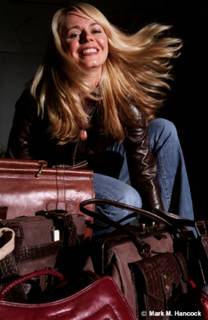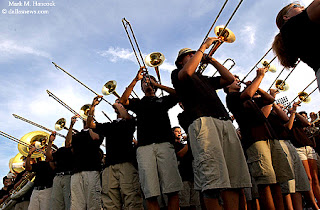 Southlake Carroll's Adam Hansen (No. 31, left) sacks Coppell's Ross McKnight (No. 5, right) during a high school football game against Coppell at Dragon Stadium in Southlake on Friday, November 7, 2003. The game's winner became the District 7-5A champion and advanced into the playoffs.*
Southlake Carroll's Adam Hansen (No. 31, left) sacks Coppell's Ross McKnight (No. 5, right) during a high school football game against Coppell at Dragon Stadium in Southlake on Friday, November 7, 2003. The game's winner became the District 7-5A champion and advanced into the playoffs.*Mark M. Hancock /
© The Dallas Morning News*Note: due to deadline, this
cutline was written while the game was still in progress. The information needed for the copy desk is available. They'll change "the game's winner" to the actual team name of the eventual champions (Southlake).
Some guidance for game action In part I of this series, we considered some
football basics. Today we'll discuss the action shots.
Obviously,
get the safe shots first.
As we did with
volleyball, we will only consider one side in the newspaper coverage zone to make things easier. The team inside the coverage area is called "home." The opposing team is called "visitors." If both teams are inside newspaper coverage, work the Average and Good shots hard before considering the rare shots. We'll also limit this example to the home team side and endzones. In an actual game, work the field as is best for the PJ and forget about which side is occupied by whom.
Let's also assume operational freedom for the PJ on the home sideline. Some teams refuse to allow PJs between the 25 yard lines. Most high school teams don't have a problem as long as the PJs don't interfere with sideline activities or give the coaches grief about jumping in front of the lens during a play (it happens at least once each quarter).
For the sake of this chapter, few teams have female players. Therefore we'll use the masculine form with the understanding there are rare exceptions. In such cases, shoot "her" the same way.
Lens conversionsThe suggestions in this entry are directed toward digital camera shooters. PJs who prefer to use film need to substitute larger lenses for those listed. Digital cameras add about a 1.5 virtual extension to each lens due to sensor size.
Get eyesAlthough it's easy to get caught up in the action and shoot the play, remember the result must work as a photo. Get the players' eyes. An image of a player's back is a follow shot, not a game shot. There are exceptions to every rule, but try to see the players' faces and save the film/disk space for the right shots.
AverageThese are the file shots of particular players. If something goes dramatically wrong, they can be used as game shots, but these are more about the players involved. They're mostly shot with a 80~200mm zoom lens, camera, monopod and frequently with a flash (on a
flash bracket is best).
The first shot is the kickoff. If the home team kicks off, shoot the kick from the visitor's 40 yard line. Get the kicker's (K) foot on the ball. If the home team is receiving, shoot the return team from the home 25 yard line. Even if they waive for a fair catch, get a shot of the receiver with the ball in his hands.
QB and RBNext the teams line up and start playing the normal gridiron game. Absolutely get the quarterback (QB). He is the critical player on the team, and he'll be talked about frequently in the newspaper. Line up three yards behind the scrimmage line. After the runningbacks (RB) take off, the QB is in a clean background. Get at least three different looks at the QB (passing downfield, passing home sideline, handing off) before moving to other players.
Next, get the RBs. These can normally work into the QB shots as well (both in one frame). Shoot from three yards behind scrimmage or on the scrimmage line itself for end-around plays. Wishbone teams run up the middle and cause a big problem for PJs unless the RB breaks out of the pack.
LinemenIf possible, get a shot of the offensive line (OL) and (if possible) a clean shot of the center as they move to the line or set into position. Do the same for the defensive line (DL).
When the home team is defending, try to get a few good open-field tackles. These normally happen about five yards in front of the scrimmage line.
Key players and coachesLook for players who get instructions from the sideline. These are key players who relay play instructions to teammates. Get some frames of them as they look back to the sideline. Get some shots of the coach barking in commands and the specialty coaches working with small groups on the sidelines.
As a final note on safe shots, get something (anything). If the lights are really miserable, the PJ may max out their
EV controls and still need to shoot f/2.8 at 1/60 with a 200mm. Two players stand and talk at about 1/60th. It's better than nothing. Don't rely strictly on game shots if there is absolutely no light. Find alternative ways to represent the game.
Good (job-keeper shots)Fill the FrameFill the frame. Good sports images run big. A cropped image can't run as big because it falls apart (film grain or pixels). If PJs depend on crops to make images look better, there are several problems. Fix the problems fast.
Shoot verticalsFrequently, the difference between an average and a good shot is the direction of the camera. Shoot some verticals. If PJs are close enough or have big enough glass, rotate the camera and shoot vertical for a while. It allows the action to be followed for more time before the crop gets too tight. It also helps isolate players from the rest of the chaos. As an additional bonus, vertical images tend to run larger and need less cropping.
Passing zoneAfter all the safe and average shots are in the bag, move 15 yards in front of the scrimmage line with a 200mm or 20 yards with a 300mm (300mm and 400mm respectively for film). This is the area where passes and interceptions are caught. The background cleans up considerably in this area as well.
Track the receivers with the camera, but watch the quarterback with the other eye until the ball is out of his hands. Understand where the ball is going and adjust to be on target for the reception or interception.
Get the sackWhen the home team is on defense, move three yards behind the visitor's scrimmage line and wait for a sack. The best sacks happen as the quarterback has his arm back and the defender puts a helmet into his spine. The quarterback shows plenty of expression, there's a ball and defender. This shot works.
Shoot from the endzoneMove to the back, center of the endzone when the scrimmage line is at the 30-yard marker (300mm and 400mm) or the 20-yard marker (200mm). Look for a running push up the middle or any touchdown pass attempts toward the corners. This is a good time to have an autofocus 50mm on the PJs 2nd camera. As the players get closer, PJs need to widen out the frame to catch what's happening (otherwise PJs get part of a number instead of the touchdown).
Field goals and extra pointsOn fieldgoal and extra point attempts, line up on the scrimmage line and focus on the holder. If it's a kick, the K moves to this same place. Save the background blur for other shots. If the holder fakes, get the run or throw and try to get the reception if possible.
ExcellentMany of these shots are attributed to a lot of luck and preparation (nobody knows when a helmet will fly) or near-death encounters with the second camera.
Use two camerasFollow the action as long as possible with long glass. When PJs sees the QB look at the PJs, it's coming. Switch to the wider lens (50mm or wide lens). The second camera should be hanging around the PJ's neck, and switched to "on" during the game. Hopefully the PJ knows the framing area without directly looking through the camera. Keep the camera pointed to the center of the action and jump up and away when the action is about to crush the PJ (but keep firing). PJs may not get anything but dead frames, but there might be a diamond in there. The other camera and monopod should be in the PJ’s non-shooting hand at the time.
Long glassUse the biggest lens possible (500mm or 600mm) to get ultra tight shots of key players. During daylight a teleconverter can be used. At night, remember there's at least a 1.5 stop light loss. Make sure the EV can handle the loss.
Layer imagesCheck out potential foreground and/or background elements for layered images. Pre-think the play required for the image. Find the negative space to place the player. When it looks possible, line up and hope.
Extreme anglesUse some extreme angles. Shoot from the top of the press box. Try some endzone shots from the ground in a prone position (aim the flash carefully for this one). Some covered stadiums may allow (with enough coaxing) remote cameras in the rafters. Lock it into place and tape all the pieces together and use it when possible. Otherwise, try a monster lens on a tripod with a remote on the press box, endzone stands or a nearby building. Focus on a likely area such as the goal line corners and hope.
Ultra-wideTry some ultra-wide shots. Put the 17mm on a film camera and actually try to use it as a main camera for passes. Yes, I know this is deliberately putting the PJ in harm's way, but think of how cool the image looks. I can't find it on his site now, but
Ryan Donnell had an award-winning touchdown shot this way that was simply amazing. At the time, he said it wasn't a calm moment in his life.
Pans and other stuffTry panning on the running backs in the open field. Consider a pan with a rear-synch flash to give the players a Superman look. Look at other images and see how to replicate it and then up the ante. Finally, look around for anything reflective or translucent to give an overshot sport a new look.
Enough for now,














